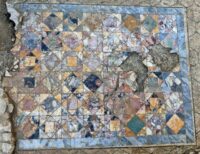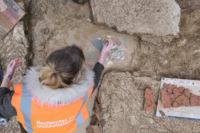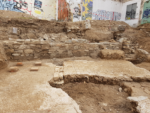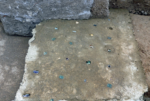 Archaeologists have discovered the remains of a richly decorated Roman villa from the imperial era in Nîmes, southern France. The find site is slated for development, and a preliminary survey indicated the presence of Roman remains. The subsequent excavation unearthed parts of two Roman villas from the 1st-2nd century, and while the boundaries of the dig were limited to the area of the future apartment building, almost the entire reception room of one domus was revealed.
Archaeologists have discovered the remains of a richly decorated Roman villa from the imperial era in Nîmes, southern France. The find site is slated for development, and a preliminary survey indicated the presence of Roman remains. The subsequent excavation unearthed parts of two Roman villas from the 1st-2nd century, and while the boundaries of the dig were limited to the area of the future apartment building, almost the entire reception room of one domus was revealed.
 The room is richly appointed. One section of the floor is decorated with hexagonal tiles laid in a honeycomb pattern. At one end is a square mosaic “carpet” in the opus sectile style. An array of different multicolored marbles from all over the Empire were cut into shapes and inlaid in a checkerboard pattern.
The room is richly appointed. One section of the floor is decorated with hexagonal tiles laid in a honeycomb pattern. At one end is a square mosaic “carpet” in the opus sectile style. An array of different multicolored marbles from all over the Empire were cut into shapes and inlaid in a checkerboard pattern.
In an extremely rare find, the painted plaster coating decorating two walls of the room had collapsed inwards onto the floor. The back of the plaster  was scored in chevron shapes to aid in adhesion, and trace materials stuck to the back indicate it was applied to earthen walls. The face of the plaster layer is frescoed in large panels of red with black inter panels.
was scored in chevron shapes to aid in adhesion, and trace materials stuck to the back indicate it was applied to earthen walls. The face of the plaster layer is frescoed in large panels of red with black inter panels.
Neighboring spaces underscore the luxurious features of the domus. Four pilae stacks (stacks of square tile used to raise the floor to allow heated air  to circulate underneath it) are the telltale remnants of a private bath. One room’s concrete floor is decorated with marble cabochons inset in a grid pattern. In the courtyard are the remains of a semicircular fountain basin originally covered with prized white Carrara marble.
to circulate underneath it) are the telltale remnants of a private bath. One room’s concrete floor is decorated with marble cabochons inset in a grid pattern. In the courtyard are the remains of a semicircular fountain basin originally covered with prized white Carrara marble.
Settled since the Bronze Age, the Roman city Nîmes was founded in the 1st century B.C. as Colonia Nemausus, a colony for retired veterans of Julius Caesar’s Egyptian campaigns named after the principle deity of the local Volcae Arecomici people. The domus was found 300 or so feet from the Maison Carrée, a Roman temple dedicated to August Caesar’s grandsons Gaius and Lucius in the first years of the first century that is so intact and so beautifully restored it looks like a replica.
 Located in the heart of historic Nîmes, the remains of the villas have been much damaged and interfered with by subsequent construction. Even so, archaeologists hope studying the surviving structural and decorative elements will shed new light on the buildings and their organization in the block of the Roman city.
Located in the heart of historic Nîmes, the remains of the villas have been much damaged and interfered with by subsequent construction. Even so, archaeologists hope studying the surviving structural and decorative elements will shed new light on the buildings and their organization in the block of the Roman city.
Stunning “carpet”.
The back of the plaster was not scored, of course, but the substrate was…
gee, never thought the romans knew how to properly tile and plaster.—modern day person, unfortunately
Parts of two villae were found, of which almost an entire reception room fitted into the area of a planned apartment block.
Thus, I wonder what the Romans would have thought about the modern building block, maybe similar to the ‘plebeian’ ones they already owned back in Rome, and –most strikingly– maybe there would not even be marble carpets :ohnoes:
———-
inrap.fr/sites/inrap.fr/files/styles/album/public/thumbnails/image/5-c_pascal_druelle_inrap_rue_pelloutier_tranche_1.png